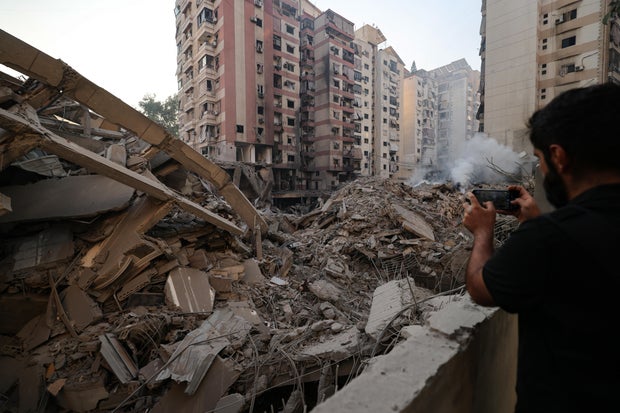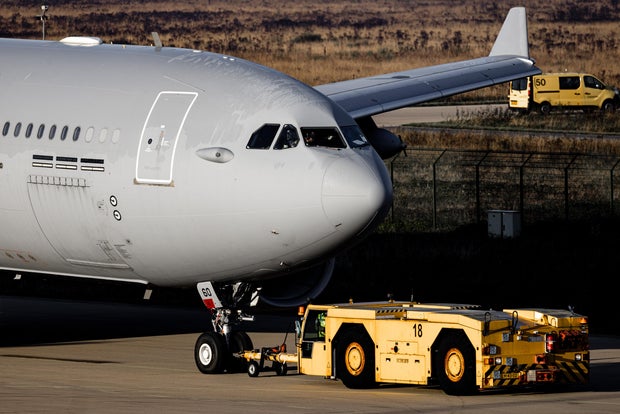CBS News
U.S. orders cow testing for bird flu after grocery milk tests positive

The Agriculture Department is ordering the dairy industry to test milk-producing cows for infections from highly pathogenic avian influenza, or HPAI H5N1, before they’re moved between states, federal officials announced Wednesday.
USDA’s move to ramp up testing requirements for HPAI H5N1 comes after the Food and Drug Administration disclosed Tuesday that samples of pasteurized milk that had been sold on grocery store shelves had tested positive for the virus, prompting further research to verify if the positive test was caused by lingering dead “virus particles” or live infectious virus.
It also comes after federal authorities say they have now spotted some “isolated” but worrying changes to the virus in cows, which are believed by U.S. officials to have contracted the virus from wild birds.
State veterinarians and labs that find that cattle have tested positive for the virus will be required to report their results to the USDA. Farms with cows that are sick will need to undergo investigations before moving cattle across state lines.
“The primary focus of the order, initially, will be lactating cattle. But we will certainly have the opportunity to expand beyond that as necessary,” Mike Watson, head of the USDA’s Animal and Plant Health Inspection Service, told reporters Wednesday.
Officials previously said that the unprecedented spread of the virus among dairy cattle likely traces to a single spillover event from wild birds, based on an analysis of genetic sequences collected from sick cattle.
Since then, genetic data and investigations suggest the virus has spread to infect cows across at least eight states and a human dairy worker in Texas. Egg farms from Texas and Michigan are also suspected to have been infected by virus that spread from cows, adding to millions of poultry culled because of infections from wild birds.
“Those farms have been in close proximity to affected dairy farms. And so there could be lateral flow from the dairy farms to these poultry operations, to these egg laying operations. This could be such things as transfer of the virus through fomites, such as on clothing or on vehicles,” National Milk Producers Federation chief science officer Jamie Jonker said at recent Swine Health Information Center webinar.
The virus was not initially found in the respiratory tract of most infected cows, officials said, suggesting it is not spreading through the air between cows like other kinds of influenza. Instead, H5N1 HPAI in the current outbreak has been found almost exclusively in raw milk and the cow organs that produce it. Officials think the virus may have spread between cows during the milking process on farms, through surfaces contaminated with infected raw milk.
However, Watson said that at least one cow headed to slaughter has now been found with signs of the virus in its lung tissue. The cow was condemned by USDA inspectors and did not enter the food supply, Watson said.
Federal scientists have also found a mutation in another sick cow from Kansas that had a genetic change that adapted the flu to spread better in mammals.
“The one sequence shift and the one dairy cow with H5N1 in the lung tissue so far appear to be isolated events. However, the novel movement of H5N1 between wild birds and dairy cows requires further testing,” Watson said.
Cows mostly have been recovering from the virus without dying, Watson said. That’s in stark contrast to the kind of mass die-offs seen in birds and some other species. However, dairy industry officials have previously said some cows have yet to recover their ability to produce milk, raising concerns of long-term issues for some cattle.
“We need time to develop an understanding to support any future courses of action. So this federal order is critical to increasing the information available for USDA,” said Watson.
H5N1 HPAI virus found in pasteurized milk
While health authorities say they think previous work pasteurizing eggs for HPAI H5N1 and milk for other germs suggests the process will be enough to eradicate the danger from any lingering traces of the virus found in milk, they say studies are also ongoing now to verify that pasteurized milk remains safe.
“A positive PCR test does not necessarily mean that the sample contains an intact infectious pathogen and that additional testing is required to determine whether intact pathogen is still present and if it remains infectious,” Don Prater, head of the FDA’s food safety center, said at the news briefing.
This involves what FDA says is the “gold standard” for checking if the virus that they found is potentially infectious, taking the H5N1 HPAI particles they found and seeing if it will grow in chicken eggs.
Research backed by the National Institutes of Health has also found H5N1 HPAI fragments in milk. Early testing of those samples suggests the virus in the pasteurized milk was not infectious, trying to grow the virus in cells and chicken eggs.
“While this is welcome news, the effort studied a small number of samples that is not necessarily representative of all retail milk. So to really understand the scope here, we need to wait for the FDA,” said National Institute of Allergy and Infectious Diseases Director Dr. Jeanne Marrazzo.
Prater said that the samples had come from a national survey of the U.S. milk supply, but declined to share details of where they had been found and what kinds of milk have tested positive.
“We don’t have information yet to share but it will be coming out very shortly and that’s what I can share at this point,” said Prater.
Milk from cows known to be sick with symptoms of the virus is not entering the supply chain, Prater said. But it is possible that the virus could be making it into the supply chain from other sources, Prater said, possibly from cows that are not yet symptomatic or have previously recovered.
FDA has some data that could help investigators trace where the milk with the virus made it into the food supply, Prater said.
“Right now we will be able to look at information that we are collecting as part of this. Our traceability information is good, but it’s not perfect,” said Prater.
CBS News
Israel airstrikes rock parts of Lebanon as Hezbollah launch rockets at air base near Haifa

The escalating fighting between Israel and Hezbollah continued Saturday as both sides traded strikes as the war in Gaza nears one year.
The Israel Defense Forces said its air force struck Hezbollah fighters inside a mosque in southern Lebanon that they said was used as a command center to “plan and execute terrorist attacks against IDF troops and the State of Israel.”
The mosque was adjacent to Salah Ghandour Hospital in the town of Bint Jbeil. The hospital said in a statement that Israeli forces had shelled it after being warned to evacuate. The shelling “resulted in nine members of the medical and nursing staff being injured, most of them seriously,” while most of the medical staff were evacuated. On Thursday, the World Health Organization said 28 health workers in Lebanon had been killed in the past 24 hours.
ANWAR AMRO/AFP via Getty Images
At the same time, 12 Israeli airstrikes hit Beirut’s southern suburbs, including one that badly damaged a large hall Hezbollah used to hold ceremonies, Lebanon’s state news agency said.
Later in the day, more strikes hit the area, from which tens of thousands of people have fled over the past two weeks.
Israeli airstrikes also hit areas in southern and eastern Lebanon, according to state media. At least six people were killed, according to NNA.
Meanwhile, Hezbollah said it launched a series of rockets at an Israeli air base near Haifa, about 30 miles from the Lebanese border. Israeli police said fragments of interceptors fell in several sites but no injuries were reported, according to the Associated Press.
Israel has sharply expanded its strikes on Lebanon in recent weeks after nearly a year of exchanging fire with the Iran-backed Hezbollah — long designated a terrorist organization by the U.S., Israel and many other nations. The IDF has been carrying out nightly bombardment of Beirut’s once densely populated southern suburbs, a stronghold of Hezbollah. Overnight, a military spokesman issued three alerts for residents there to evacuate.
Houssam Shbaro/Anadolu via Getty Images
Nearly a week of Israeli ground operations in southern Lebanon, near Israel’s northern border, and two weeks of airstrikes in that region and in southern Beirut — both Hezbollah strongholds — had killed more than 2,000 people, the health ministry said. More than 1 million people have been driven from their homes, including tens of thousands under Israel evacuation orders in almost 100 towns and villages near the border.
Hezbollah started launching those attacks in support of its ideological ally Hamas, which is also backed by Iran, the day after Hamas sparked the ongoing war in Gaza with its Oct. 7, 2023 terrorist attack on Israel. The IDF says Hezbollah militants have fired over 10,000 rockets across the border since Oct. 8, 2023. The vast majority of them have been intercepted by Israel’s advanced missile defense systems.
Israel conducts more ground raids
The Israeli military said on Saturday its special forces were carrying out ground raids against Hezbollah infrastructure in southern Lebanon, destroying missiles, launchpads, watchtowers and weapons storage facilities. The military said troops also dismantled tunnel shafts that Hezbollah used to approach the Israeli border.
Some 1.2 million people have been driven from their homes since Israel escalated its strikes in late September aiming to cripple Hezbollah and push it away from the countries’ shared border. On Tuesday, Israel launched what it calls a limited ground operation into southern Lebanon.
Nine Israeli troops have been killed in close fighting in the area in the past few days, which is saturated with arms and explosives, the military said.
Americans attempt to leave Lebanon
The U.S. government has warned Americans not to travel to Lebanon since mid-September and urged any citizens in the country to leave via commercial travel routes. As of Friday night, the U.S. State Department has assisted approximately 500 U.S. citizens, permanent residents and their families to leave Lebanon on flights organized by the agency.
Other nations are also working to evacuate their residents from Lebanon. Germany has evacuated 460 citizens on German military flights, while a Dutch military transport plane carried more than 100 citizens out of Lebanon. There were also citizens of Belgium, Finland and Ireland who were repatriated on that flight.
ROB ENGELAAR/ANP/AFP via Getty Images
“It’s great that these people are safely back in the Netherlands. These have been tense times for them,” Christiaan Rebergen, secretary-general of the foreign ministry, said after they landed Friday.
Fighting ongoing in Gaza
Palestinian medical officials say Israeli strikes in northern and central Gaza early Saturday have killed at least nine people, including two children.
One strike hit a group of people in the northern town of Beit Hanoun, killing at least five people, including two children, according to the Health Ministry’s Ambulance and Emergency service.
Another strike hit a house in the northern part of Nuseirat refugee camp, killing at least four people, the Awda hospital said. The strike also left a number of wounded people, it said.
The Israeli military did not have any immediate comment on the strikes but has long accused Hamas of operating from within civilian areas.
Earlier in the day, the Israeli military had warned residents in parts of central Gaza to evacuate, saying its forces would soon operate there in response to Palestinian militants.
The warnings cover areas along a strategic corridor in central Gaza, which was at the heart of obstacles to a ceasefire deal earlier this summer. The military warned Palestinians in areas of Nuseirat and Bureij refugee camps, located along the Netzarim corridor, to evacuate to an along Gaza’s shore called Muwasi, which the military has designated a humanitarian zone. It’s unclear how many Palestinians are currently living in the areas affected by the order, parts of which were evacuated previously.
Almost 42,000 Palestinians have been killed in Gaza during the almost year-long war, according to the Palestinian Health Ministry, which does not differentiate between civilian and militant deaths.
CBS News
1-month-old twins who died with mother believed to be the youngest-known Hurricane Helene victims

Month-old twin boys are believed to be the youngest known victims of Hurricane Helene. The boys died alongside their mother last week when a large tree fell through the roof of their home in Thomson, Georgia.
Obie Williams, grandfather of the twins, said he could hear babies crying and branches battering the windows when he spoke with his daughter, Kobe Williams, 27, on the phone last week as the storm tore through Georgia.
The single mother had been sitting in bed holding sons Khyzier and Khazmir and chatting on the phone with various family members while the storm raged outside.
AP
Kobe’s mother, Mary Jones, was staying with her daughter, helping her take care of the babies. She was on the other side of the trailer home when she heard a loud crash as a tree fell through the roof of her daughter’s bedroom.
“Kobe, Kobe, answer me, please,” Jones cried out in desperation, but she received no response.
Kobe and the twins were found dead.
“I’d seen pictures when they were born and pictures every day since, but I hadn’t made it out there yet to meet them,” Obie Williams told The Associated Press days after the storm ravaged eastern Georgia. “Now I’ll never get to meet my grandsons. It’s devastating.”
The babies, born Aug. 20, are the youngest known victims of a storm that had claimed more than 200 lives across Florida, Georgia, Tennessee, Virginia and the Carolinas. Among the other young victims are a 7-year-old girl and a 4-year-old boy from about 50 miles (80 kilometers) south in Washington County, Georgia.
“She was so excited to be a mother of those beautiful twin boys,” said Chiquita Jones-Hampton, Kobe’ Jones’ niece. “She was doing such a good job and was so proud to be their mom.”
Jones-Hampton, who considered Kobe a sister, said the family is in shock and heartbroken.
In Obie Williams’ home city of Augusta, 30 miles east of his daughter’s home in Thomson, power lines stretched along the sidewalks, tree branches blocked the roads and utility poles lay cracked and broken. The debris left him trapped in his neighborhood near the South Carolina border for a little over a day after the storm barreled through.
He said one of his sons dodged fallen trees and downed power lines to check on Kobe, and he could barely bear to tell his father what he found.
Many of his 14 other children are still without power in their homes across Georgia. Some have sought refuge in Atlanta, and others have traveled to Augusta to see their father and mourn together, he said.
He described his daughter as a lovable, social and strong woman. She always had a smile and loved to make people laugh, he said.
And she loved to dance, Jones-Hampton said.
“That was my baby,” Williams said. “And everybody loved her.”
CBS News
Telecom providers operate emergency communications after Hurricane Helene

Watch CBS News
Be the first to know
Get browser notifications for breaking news, live events, and exclusive reporting.











